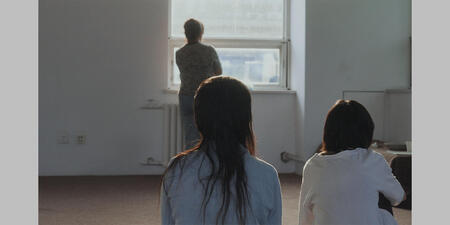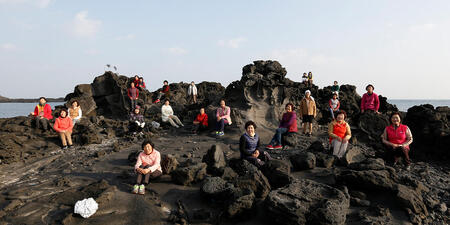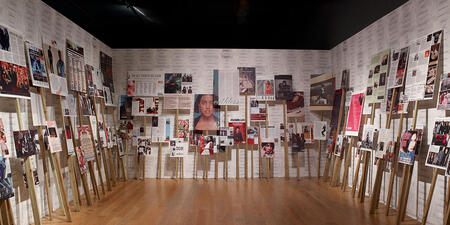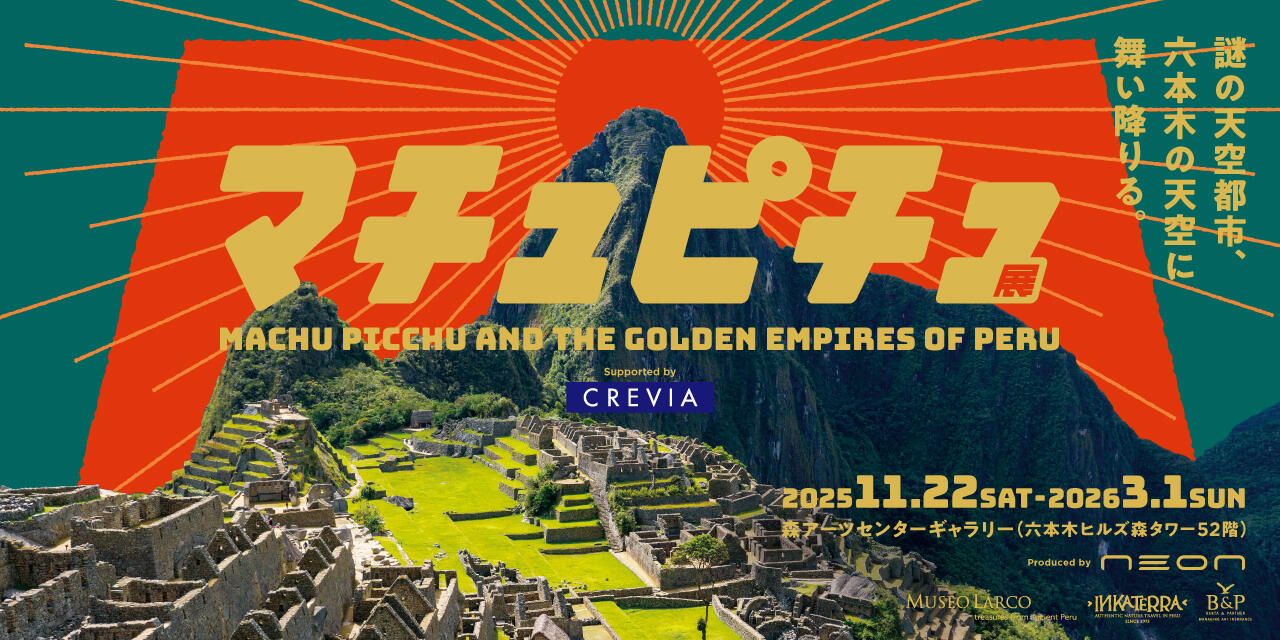Highlights of the Exhibition
1.New Works Across Diverse Media
Many of the artists are presenting new works at this exhibition. In addition to A.A.Murakami’s new large-scale installation The Moon Under the Water, a work made out of soap bubbles operated by an AI-written operating system, the exhibition features a diverse range of media including new paintings and a sculpture by Hiro Naotaka, sculpture by Wada Reijiro, and video work by Maya Watanabe.
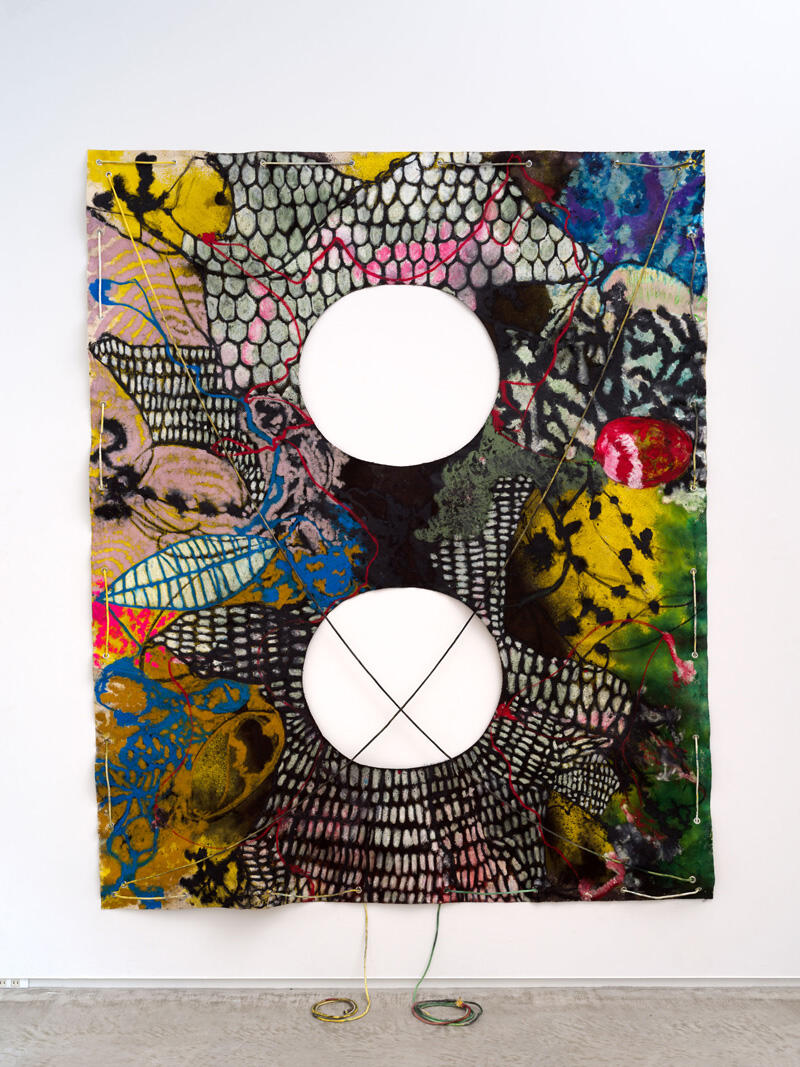
Untitled (Frequency)
2025
Canvas, fabric dye, oil pastel, rope, and grommet
261.6 x 213.4 cm
Courtesy: MISAKO & ROSEN, Tokyo
Photo: KEI OKANO
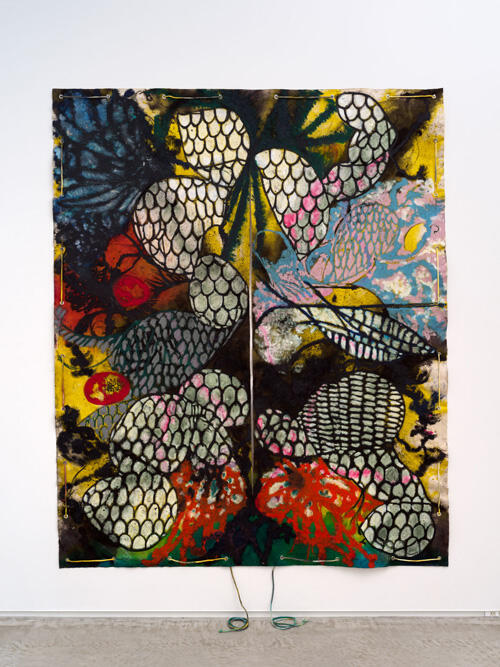
Untitled (Grounding)
2025
Canvas, fabric dye, oil pastel, rope, and grommet
261.6 x 213.4 cm
Courtesy: MISAKO & ROSEN, Tokyo
Photo: KEI OKANO
2. Interactive and Participatory Experiences
In addition to experiencing and playing Kihara Tomo’s AI game, visitors can also join Miyata Asuka’s Traveling Knitting’n Stitching Club during the exhibition period. Amefurashi introduces traditional craft preservation projects like straw sandal making through workshops, while Kitazawa Jun leads batik workshops. When the works by ZUGAKOUSAKU & KURIEITO are dismantled on the final day of the exhibition, visitors can take their favorite parts home with them.
3. Japan, in the Global Art Scene
This exhibition offers a clear demonstration of how “Japanese art” is no longer confined to nationality or geographical boundaries. Kelly Akashi poetically expresses themes of body, memory, the fleeting and the eternal through her bronze and glass sculptures, while Carrie Yamaoka employs analog photographic processes to create a cycle of work around historical memory, erasure and landscape. In the works of Akashi and Yamaoka, both Japanese Americans, one can find a sense of lyricism seen in Japanese artistic expression that resonates across borders and generations. Shooshie Sulaiman, though a Malaysian artist, has long been engaged with art projects rooted in the local history and community of Onomichi. These works, which express themes of memory, migration, and border-crossing from a diverse range of perspectives, recount Japanese society and culture in various forms.
Four Perspectives
Four perspectives for interpreting the exhibition theme of “time” will give visitors an understanding of the links between a diverse range of works.
Scales of Time: Personal/Universal Time
The first gallery showcases works that explore the relationship between a variety of personal experiences and universality. Kelly Akashi’s work, based on memories of family interned in Japanese-American camps, demonstrates how personal experiences, passed down and woven into the fabric of time, acquire universal significance. Meanwhile, Shoji Asami and Hiro Naotaka create paintings that impose constraints on the body – the foundation of experience for all of us - prompting us to reconsider its existence. Oki Junko’s delicate embroidered works reconnect the individual with society and the past with the present, tracing family memories that reside in handiwork and fabric. Kuwata Takuro boldly references the techniques and history of Japanese ceramics while exploring new expressive possibilities. These artists capture moments where personal experience gains universal meaning by connecting the limited span of an individual life with time on the differing scales of the everyday, the body, and history itself.
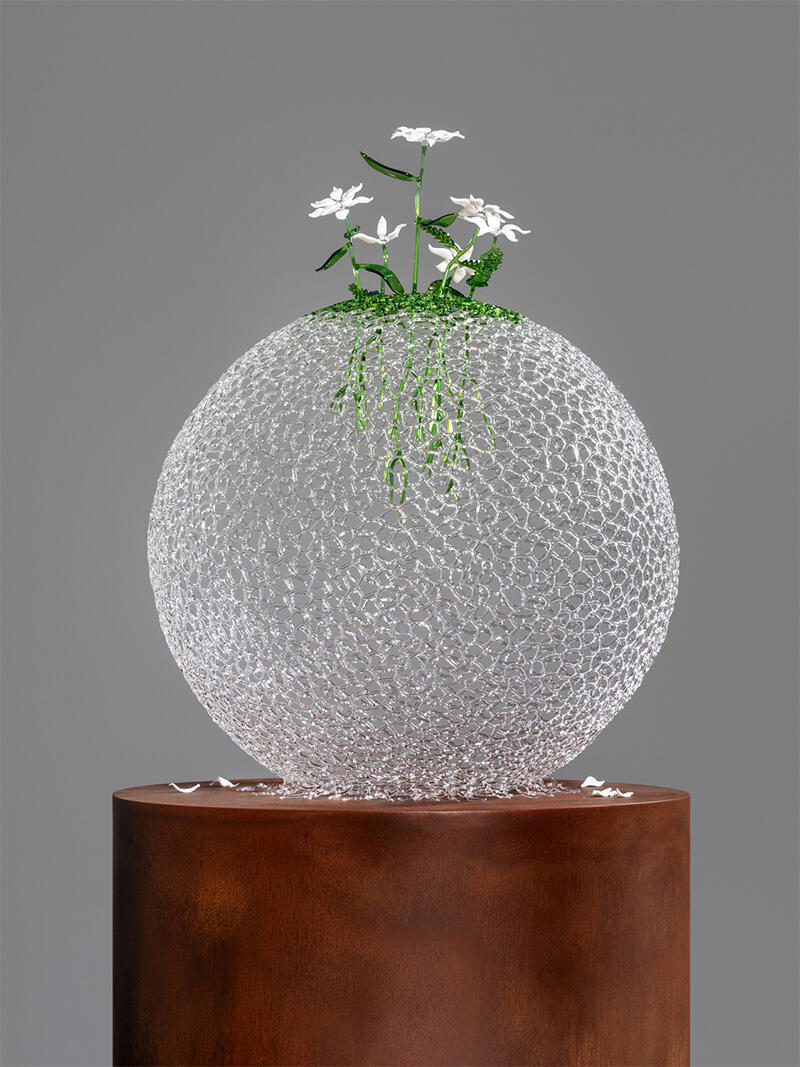
Monument (Regeneration)
2024-2025
Flame-worked borosilicate glass and weathering steel
66 x 43.2 x 43.2 cm
Courtesy: Lisson Gallery
Photo: Dawn Blackman
* Referential image

Monument (Regeneration)
2024-2025
Flame-worked borosilicate glass and weathering steel
66 x 43.2 x 43.2 cm
Courtesy: Lisson Gallery
Photo: Dawn Blackman
* Referential image
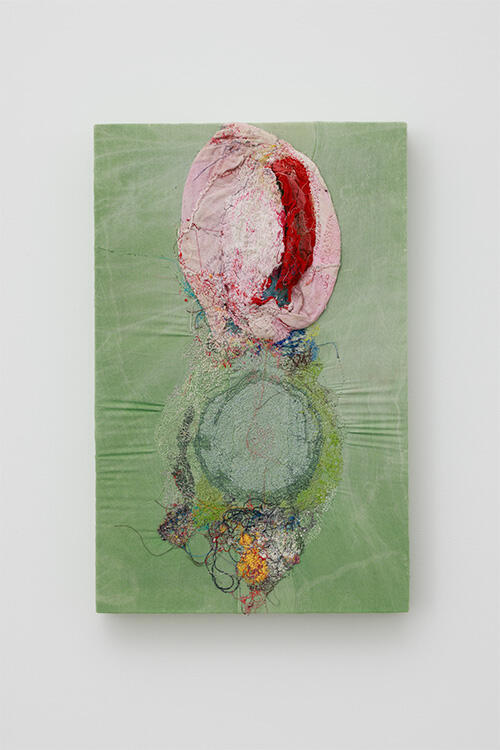
La Dolce Vita
2022
Cotton, hemp, and silk
55.0 x 35.5 x 9.8 cm
Courtesy: KOSAKU KANECHIKA, Tokyo
Photo: Kioku Keizo
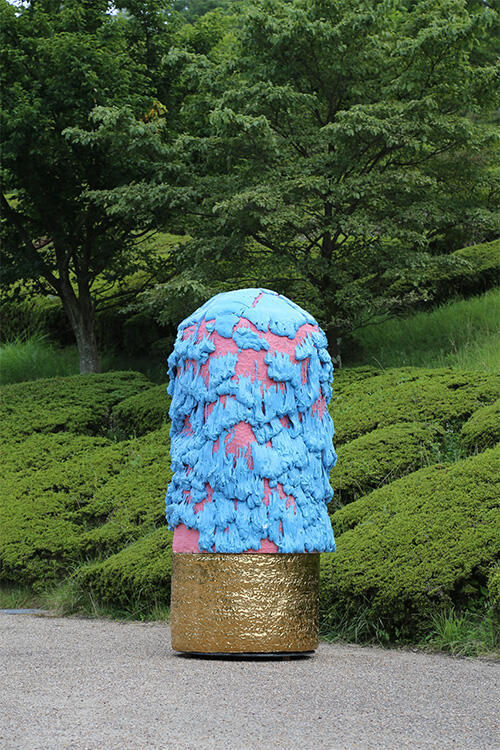
Untitled
2016
Porcelain, glaze, pigment, steel, gold, and lacquer
288 x 135 x 130 cm
* Referential image
Sensing Time
Showcased next are works that evoke the existence of diverse times, beyond the uniform time measured by clocks. A.A. Murakami’s large-scale installation uses fluid elements such as fog and light to create an experience that envelops the viewer at both a physical and psychological level. Here, time is slowly dilated, and viewers find themselves deeply immersed in the “here and now.” ZUGAKOUSAKU & KURIEITO recreate entrances and exits of Roppongi Station using materials like cardboard and watercolor. Through a production process that is not premised on a permanent state of conservation, they express the fleeting essence of time. Gardar Eide Einarsson freezes sound by painting closed captions (a type of subtitle displaying dialogue and sound effects as text), condensing emotions and imagery onto the canvas. In Hosoi Miyu’s sound installation, which employs voices and ambient sounds of people who gather at specific locations, the diversity of temporal flow and passage hidden within everyday life emerges. Wada Reijiro’s three-dimensional work using brandy explores temporal concepts such as eternity and evanescence, and infinity and finitude. Araki Yu creates a kind of time that permits the contemplation of language, sound, and memory through video works that slow the perception of the viewer, demonstrating that time is not uniform, and can be perceived in diverse ways.
Time Together
These works demonstrate how historical time persists in the present, and how an interpersonal understanding emerges through collaborative processes. Inspired by the fact that the Japanese military’s Hayabusa fighter planes used in the invasion of Java were later reused by the Indonesian military during their war of independence, Kitazawa Jun’s project revives the Hayabusa through the hands of Indonesian kite artisans, offering a dynamic portrayal of the traces of war connecting both nations through the memories and craftsmanship of the people involved. Miyata Asuka fosters communities where a diverse range of individuals share life experiences, memories, and skills through knitting and embroidery, enabling them to function as “active archives.” Amefurashi, meanwhile, makes long-term efforts to preserve local history and culture, such as former printing factories and broom-making traditions, while imbuing them with new meaning. Higaleo reflects on how the complex history and culture of Okinawa have been passed down through Ryukyu dolls, souvenirs primarily produced by women. Through zine publishing, Multiple Spirits encourages new interpretations of history from a feminist perspective. Kim Insook’s practice emphasizes the building of long-term relationships with specific communities, highlighting how sustained engagement is essential for genuine cross-cultural understanding.
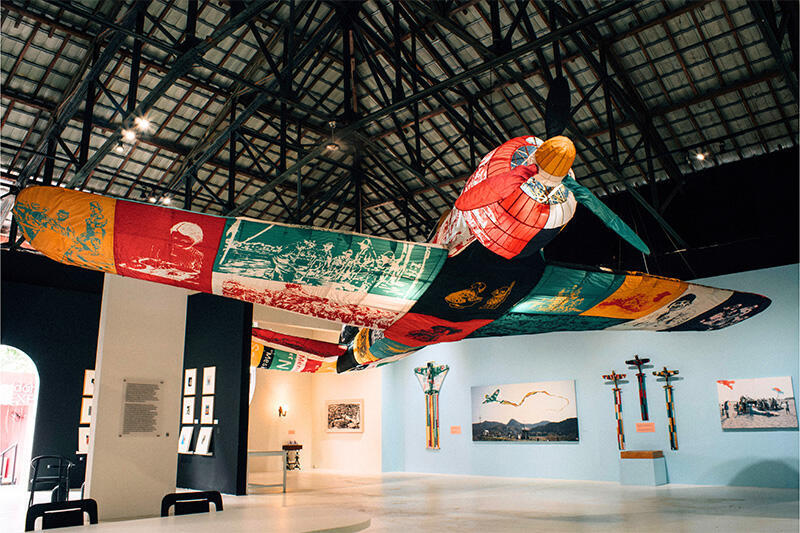
Fragile Gift: The Kite of Hayabusa
2024
Bamboo, rattan, printed fabric, and cord
210 x 3,870 x 1,090 cm
Installation view: ARTJOG 2024, Jogja National Museum, Yogyakarta, Indonesia
Photo: Aditya Putra Nurfaizi

Fragile Gift: The Kite of Hayabusa
2024
Bamboo, rattan, printed fabric, and cord
210 x 3,870 x 1,090 cm
Installation view: ARTJOG 2024, Jogja National Museum, Yogyakarta, Indonesia
Photo: Aditya Putra Nurfaizi
Rhythms of Life
These works express how time flows as every being in the world marks its own unique rhythm of life. These pieces confront us with the way in which time shapes the present across multiple scales, and irreversibility of human temporal experience. Shooshie Sulaiman, who has traveled between Muar in Malaysia and Onomichi, Hiroshima in Japan for over a decade, created an installation using roof tiles taken from abandoned houses in Onomichi. Through these tiles, she connects Onomichi’s pastvto its present, its former inhabitants, and herself as the artist.
Carrie Yamaoka’s photographic works represent a mapping of landscapes of forced relocation and confinement by listing the locations of prisons and detention facilities in alphabetical order. Maya Watanabe presents mammoth remains that emerge from thawing permafrost in her video work, alluding to existence on a temporal scale that transcends human history. Kihara Tomo uses AI-simulated life paths to demonstrate the irreversibility of our life choices.
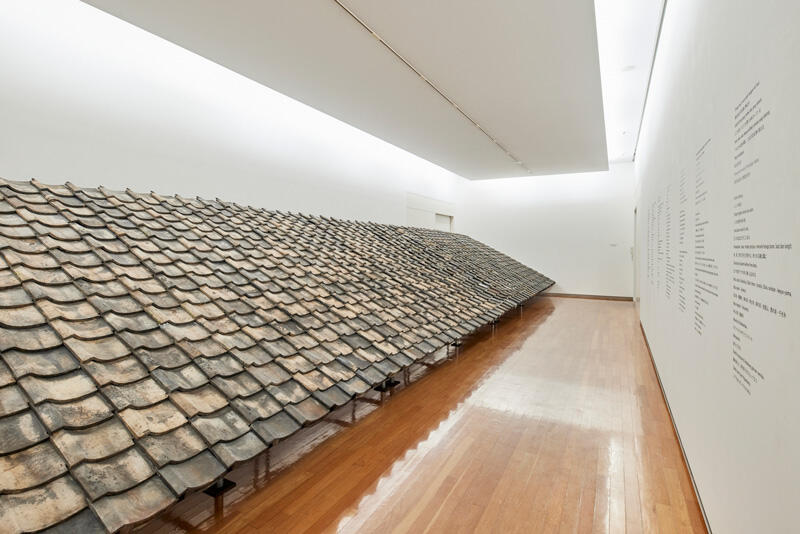
Installation view from NEW LANDSKAP shooshie sulaiman, Onomichi City Museum of Art, Hiroshima, Japan, 2023
Photo: Kenji Takahashi

Installation view from NEW LANDSKAP shooshie sulaiman, Onomichi City Museum of Art, Hiroshima, Japan, 2023
Photo: Kenji Takahashi



